Larger birds like emus can drink up to 9 to 18 liters (2.5 to 5 gallons) of water daily. Smaller birds, such as finches, need only 15 ml (0.5 oz) per day. This shows how important water is for birds.
We will explore how birds drink and stay hydrated. We’ll look at their water sources, how they adapt, and their unique ways of drinking. This will help us understand how to keep our feathered friends healthy.
Key Takeaways
- Birds need clean, fresh water to stay hydrated and survive.
- Water intake varies by bird species, from a few ounces to several gallons daily.
- Birds get moisture from drinking and eating, but drinking water is crucial.
- Having a reliable water source in your backyard can attract birds more than food.
- Knowing the water needs and adaptations of different birds is vital for their health.
Understanding Bird Hydration Basics
Birds need different amounts of water, depending on their size. Big birds like emus drink 9-18 liters a day. Small birds, like finches, only need about 15 ml. Most birds drink water a few times a day to replace lost moisture.
They don’t sweat, but still lose water through their skin. So, it’s key for them to drink regularly to stay healthy.
Smaller birds need more water because of their bigger surface area. They can’t suck water like mammals do. Instead, they use their beaks to scoop and tilt water into their mouths.
The Importance of Regular Hydration
Drinking enough water is vital for birds. It helps with body temperature, waste, and nutrient absorption. Without enough water, birds can get very sick or even die.
How Birds Process Water
Birds have a special way to use water. Their kidneys save water, and they make uric acid, a solid waste, to lose less water. This helps them survive in dry places.
| Bird Species | Daily Water Requirement (Liters) |
|---|---|
| Emus | 9-18 |
| Finches | 0.015 |
Knowing how much water birds need is important. It helps us make sure they stay healthy. By meeting their water needs, we can help our bird friends thrive.
What Do Birds Drink?
Birds show a wide range of drinking habits. Some need water often, while others might never drink at all.
Pelicans are amazing at getting water. They scoop it up with their big beaks and carry it in a special pouch. This water is for their nests or chicks.
Hummingbirds, however, get enough water from the nectar they eat. This sweet liquid is full of moisture, so they don’t need to drink water.
Birds like hawks and owls get most of their water from their prey. They don’t often drink from water sources. But, sometimes, like the Great-horned Owl, they might take a rare dip in a pond.
| Bird Species | Drinking Habits |
|---|---|
| Pelicans | Highly efficient water-gathering system, using their large beaks and specialized pouches |
| Hummingbirds | May never need to drink water due to their nectar-rich diet |
| Birds of Prey | Obtain most of their moisture from the prey they consume, rarely needing to drink directly |
| Great-horned Owl | Rare sightings of these birds of prey drinking from ponds |
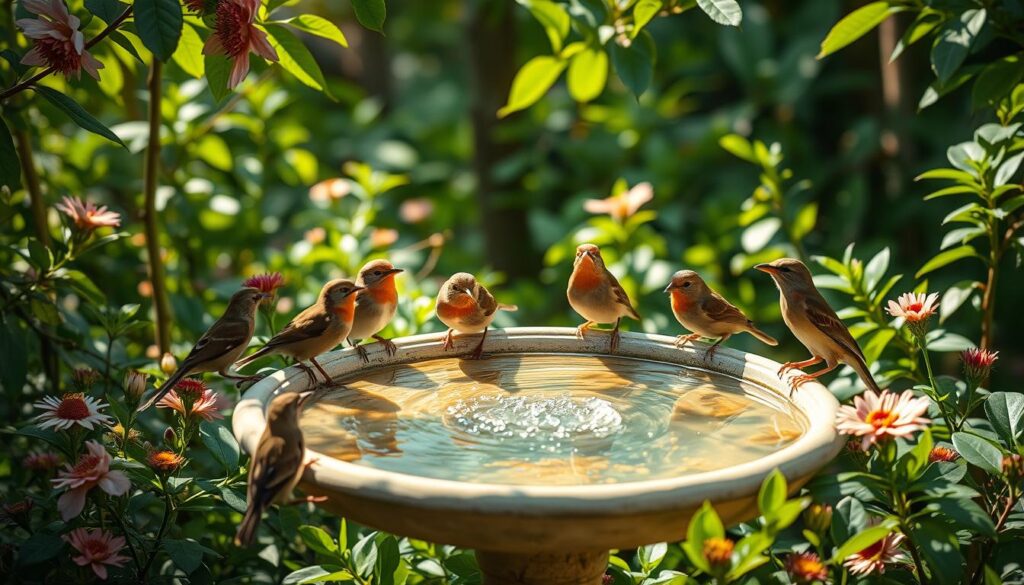
The variety in avian drinking habits shows how birds adapt to their environments. From pelicans’ water-gathering skills to hummingbirds’ nectar diet, each bird has its own way of staying hydrated.
Natural Water Sources for Wild Birds
Wild birds find many natural ways to stay hydrated. They drink from rivers, lakes, ponds, and streams. They also use morning dew and raindrops on plants and puddles after rain.
Some birds, like swifts and swallows, skim water from lakes and rivers while flying. Natural springs are another key water source in some areas.
Rivers and Lakes
Rivers and lakes are big water sources for birds. They give birds a steady supply of water. These places also support the food sources for birds, like insects and small fish.
Morning Dew and Raindrops
In milder climates, birds drink from morning dew and raindrops. These moisture sources are vital for smaller birds. They can’t always reach big water bodies.
Natural Springs and Streams
Natural springs and streams are crucial for birds. They provide clean, flowing water all year. This water is essential for birds’ survival and health.
Knowing how birds find water helps us care for them better. We can make our backyards better for birds by providing clean, easy-to-reach water.
Unique Drinking Methods of Different Bird Species
Birds have developed many ways to drink water. Most birds dip their bills and tilt their heads to swallow. But, some birds have special methods. Pigeons and doves, for instance, can suck water with their “piston tongues” without needing to tilt their heads.
Some birds, like swifts and swallows, can drink while flying. They scoop water from lakes and rivers. Hummingbirds use their forked tongues to pump nectar into their mouths. This is different from the usual dipping and tilting.
Some birds can lap water into their bills like cats and dogs. But, they still tilt their heads to swallow. This shows how different birds have adapted to drink in their own ways.
“The drinking bird has been featured in popular culture, including an episode of The Simpsons in 1995.”
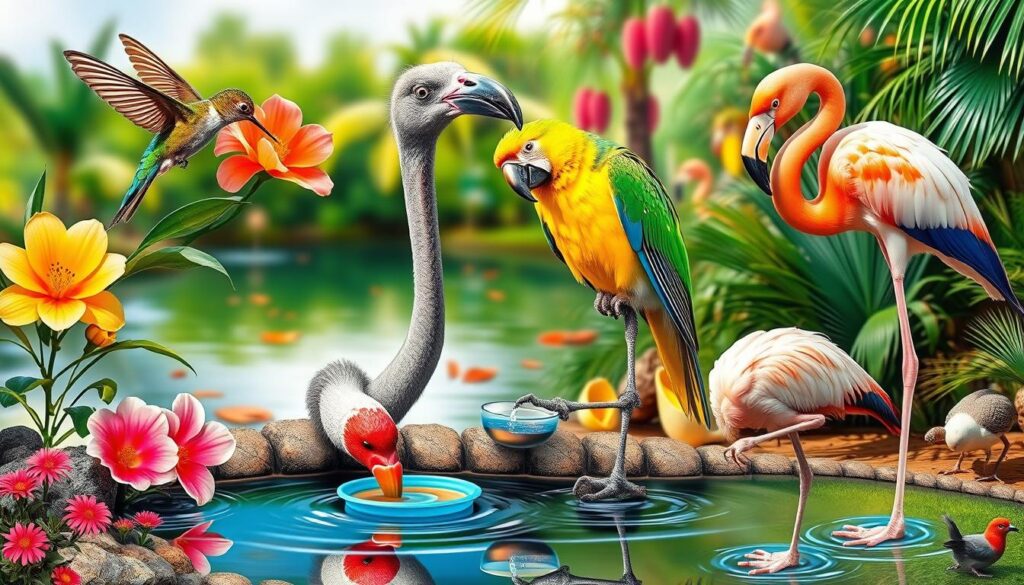
While most birds use the usual dipping and tilting, others have special ways to drink. These unique bird drinking behaviors and avian drinking habits show the amazing diversity of birds. Learning about these habits helps us understand how different birds live and adapt.
Bird Adaptations for Water Consumption
Birds have evolved amazing ways to get the water they need. They have special tongues and salt glands. These help them find and use water.
Special Anatomical Features
Pigeons and doves have “piston tongues” for drinking water. Hummingbirds have tongues with grooves to drink nectar. Some birds, like swifts and swallows, drink while flying.
Desert Bird Adaptations
Birds in dry places, like the Sonoran Desert, have special tricks. They get moisture from their food, not just water. The saguaro cactus is a key water source for them.
Seabird Water Processing
Seabirds like gulls and albatrosses can drink seawater. They have salt glands to remove excess salt. This lets them get water from the sea.
These amazing bird adaptations show their incredible diversity. They adapt to their environments and find ways to get water.
Water Requirements Based on Bird Size
The amount of water birds need daily changes with their size. Large birds, like emus, might need up to 9-18 liters (2.5 to 5 gallons) of water each day. On the other hand, smaller birds, like finches, only need about 15 ml (0.5 oz) of water daily.
Smaller birds lose water faster because of their surface area to volume ratio. This means they need more water often to stay hydrated. It’s important to watch how much water they drink and make sure it’s always clean and fresh.
| Bird Size | Daily Water Intake |
|---|---|
| Large Birds (e.g., emus) | 9-18 liters (2.5 to 5 gallons) |
| Medium Birds (e.g., pigeons) | 1-3 liters (0.25 to 0.75 gallons) |
| Small Birds (e.g., finches) | 15-30 ml (0.5-1 oz) |
Knowing how much water different birds need helps you keep them healthy. It’s key to watch their water intake and keep their water clean and easy to reach. This supports their bird water intake and providing water for birds in your care.
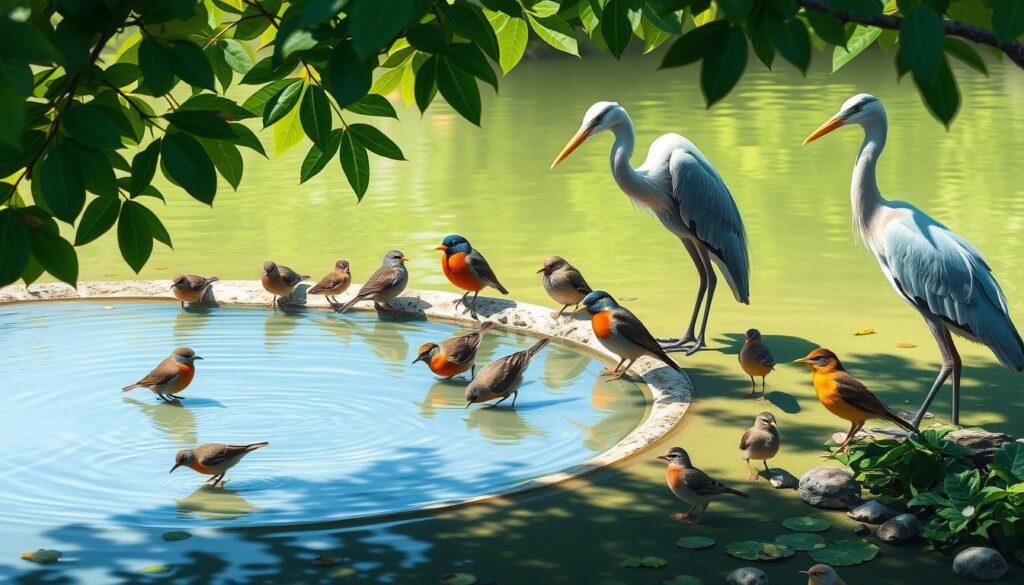
Alternative Sources of Hydration
Water is key for most birds, but they also find moisture in other ways. Learning about these methods helps us understand how birds drink. It shows us the variety in their drinking habits.
Nectar and Plant Moisture
Nectar-feeding birds, like hummingbirds, get moisture from flower nectar. They use their long beaks to reach deep into flowers. This helps them live their fast-paced lives.
Some birds, especially in dry places, get water from plant leaves and stems too.
Insects and Prey
Insect-eating birds, like flycatchers and warblers, get water from their insect food. They hunt and eat insects, which helps them stay hydrated. Birds of prey, like hawks and owls, also get water from their prey.
Fruit and Berries
Fruit-eating birds, like finches and orioles, drink from juicy fruits and berries. These foods are full of water, helping them stay hydrated when water is hard to find. Some desert birds even get all their water from their food.
Learning about how birds drink shows us their clever ways. They use nectar, insects, and fruits to stay hydrated. This helps us appreciate their adaptability and resourcefulness.
How Birds Drink in Different Seasons
Birds drink differently in each season. In winter, they might drink from melted snow, ice, or puddles. Summer brings more visits to ponds, streams, and lakes. Urban birds also use water from human sources when they can.
NWF Naturalist David Mizejewski says water is key in cold months. Without snow, birds face a big risk. Backyards with liquid water in winter attract more birds than those with frozen water.
Sally Roth, from “The Backyard Bird Feeder’s Bible,” points out water’s importance in winter. She suggests using sturdy birdbaths to avoid ice damage. Placing them in sunny spots helps keep water from freezing. Adding stones or sticks provides perches and keeps birds warm.
In summer, birds often go to ponds and streams. But they also use human water sources, especially in cities. Offering water in backyards can draw birds more than food, especially when it’s hot.
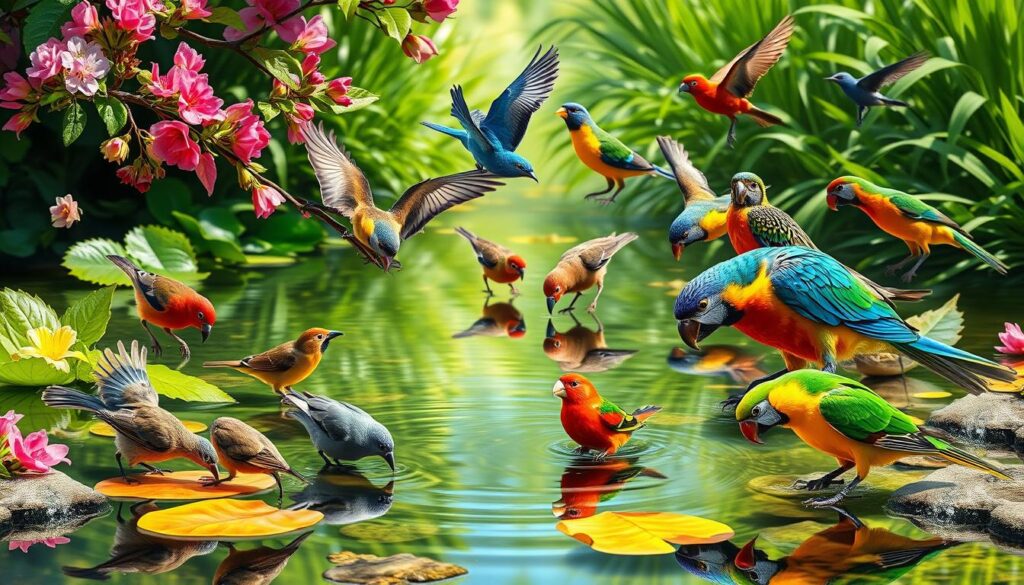
Keeping water clean and easy for birds to access all year is vital. Knowing how birds drink in different seasons helps us meet their needs. This way, we can help them thrive in various environments.
Creating a Bird-Friendly Water Source
It’s key to have a safe water spot for birds in your backyard. You can choose from a simple birdbath to a fancy water feature. Make sure your water source is inviting and easy to care for.
Birdbath Placement Tips
Where you put your birdbath matters a lot. Place it where it’s not too sunny but still easy for birds to see around. Putting it up high makes birds feel safer. Having it near plants or trees lets birds watch for danger before drinking or bathing.
Maintenance Requirements
Keeping your birdbath clean and filled with fresh water is a must. Change the water every day to stop algae and harmful germs. Use a soft brush to clean the inside of the birdbath often. In cold weather, use a heater or break ice to keep water from freezing.
Think about adding more than just a birdbath to attract different birds. Misters, ponds, waterfalls, and streams can also draw in various bird species. These features offer unique water spots that meet different bird needs.
“Providing a reliable and clean water source is one of the most important things you can do to support birds in your backyard.”
Designing and caring for your bird-friendly water spot can make your backyard a lively haven. It will be a welcoming place for birds in your area.
Birds That Rarely Drink Water
Most birds need water to stay healthy, but some don’t drink much. These birds find moisture in other ways. This shows how different bird hydration and avian drinking habits can be.
Desert birds, like the ostrich, can last up to two weeks without water. They get enough moisture from their food. Male emus, who sit on eggs, can also go a long time without drinking.
Raptors, or birds of prey, get water from their prey. This means they don’t need to drink much. It’s a clever way for them to stay hydrated.
Hummingbirds live without drinking water their whole lives. They get all the moisture they need from nectar. It’s amazing how they manage to do this.
Birds like the Barn Swallow drink water in special ways. They scoop it up while flying. Doves and pigeons use their tongues to suck up water. Blue Jays have to tilt their heads to drink.
The ways birds drink water are truly amazing. From desert birds to those that fly, their methods show how adaptable and diverse birds are. It’s a testament to their incredible resilience.
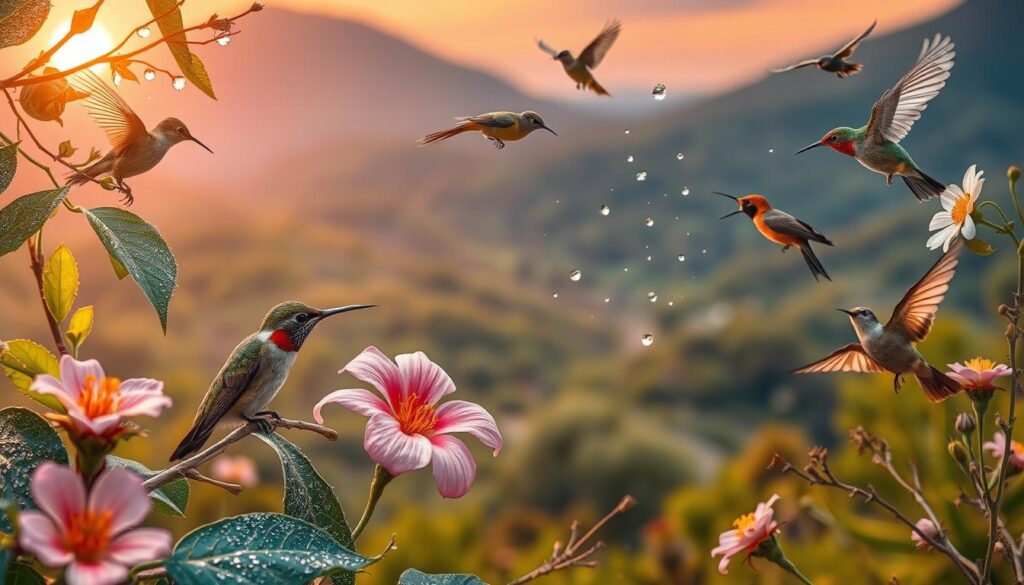
Signs of Dehydration in Birds
Dehydration is a big problem for birds, especially the smaller ones. It’s important for bird lovers and owners to know the signs of dehydration. This way, they can act fast and keep their birds healthy.
- Lethargy and decreased activity
- Sunken, dull, or dry eyes
- Dry or flaky skin
- Difficulty flying or perching
For mild dehydration, where birds lose less than 5% of their water, you can treat them at home. Mix 1 tablespoon of sugar and 1/4 teaspoon of salt in one liter of water. This is a homemade Pedialyte solution.
But, if a bird loses 5 to 9% of its water, it needs to see a vet. They might give a 5% dextrose solution or Lactated Ringer’s Solution (LRS).
Severe dehydration, where birds lose 10% or more, is very dangerous. They need to see a vet right away. These birds show dehydration all over their bodies and need quick help.
| Dehydration Level | Description | Treatment |
|---|---|---|
| Mild ( | Less than 5% water loss | Homemade Pedialyte solution |
| Moderate (5-9%) | 5 to 9% water loss | Veterinary fluid therapy |
| Severe (≥ 10%) | 10% or more water loss | Immediate veterinary intervention |
It’s key to keep birds’ water clean and fresh, especially when it’s hot. Knowing the signs of dehydration helps prevent it. This way, we can keep our feathered friends healthy and happy.
Water Safety for Birds
Keeping water safe and clean is key for our bird friends. Birds need fresh, clean water to stay healthy and hydrated. As bird lovers, we must make sure the water we offer is safe and free from harm.
Clean Water Importance
Clean water is vital for birds. It’s important to change the water in birdbaths every day and clean them often. This stops algae and diseases from spreading. When cleaning, use mild household cleaners, avoiding harmful chemicals.
Contamination Prevention
- In winter, keep water from freezing to ensure birds always have liquid water. Use water heaters or place birdbaths in sunny spots.
- Tap, filtered, and spring water are safe for birds, as long as they’re free from chemicals.
- Don’t use glycerin in birdbath water, as it can harm birds’ feathers and health.
- Watch local news for bird flu or diseases. Take steps to protect birds in your area.
By focusing on water safety and keeping water clean, you help birds in your backyard or local parks. Always put the health and safety of our feathered friends first when providing water.
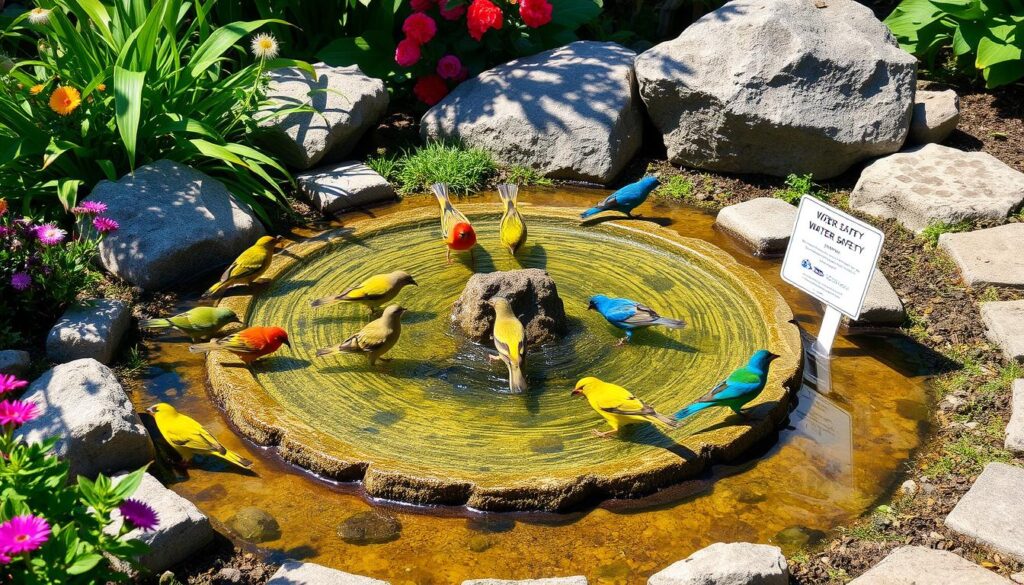
Specialized Drinking Techniques
Birds have developed amazing ways to get water from their surroundings. Hummingbirds, for example, use their long, forked tongues to suck nectar. This lets them get liquid food from flowers.
Pigeons and doves have a special “piston tongue” that lets them suck water with their beaks underwater. This helps them drink from open water. Swifts and swallows can even drink while flying, taking water from surfaces as they move.
These unique drinking habits show how different birds can get water. They have special ways to drink, whether it’s from nectar, open water, or even the air. Learning about these habits helps us understand the amazing world of birds.
FAQ
What are the daily water requirements for birds?
Birds need different amounts of water based on their size. Big birds like emus drink 9-18 liters a day. Small birds, like finches, only need 15 ml. Most birds drink a couple of times a day to stay hydrated.
Why is regular hydration important for birds?
Birds need clean, fresh water to stay alive. They don’t sweat and lose water through breathing and droppings.
How do birds process water differently from mammals?
Birds can’t suck water like mammals do. They dip their bills into water and swallow by tilting their heads back.
What are the natural water sources for wild birds?
Wild birds find water in rivers, lakes, ponds, and streams. They also get water from morning dew, raindrops, and natural springs.
How do different bird species drink water?
Most birds dip their bills into water and swallow by tilting their heads. Pigeons and doves can suck water without tilting their heads. Swifts and swallows drink while flying, scooping water from surfaces.
What adaptations do birds have for water consumption?
Birds have special ways to drink water. Pigeons and doves have “piston tongues.” Hummingbirds have long, forked tongues for nectar. Swifts and swallows drink while flying.
How do a bird’s size affect its water requirements?
Big birds like emus drink 9-18 liters a day. Small birds, like finches, only need 15 ml. Smaller birds drink more often because of their size.
What other sources of hydration do birds obtain besides water?
Birds get moisture from their food, like nectar, insects, and juicy fruits. Some desert birds get enough moisture from their food without drinking water.
How do birds’ drinking habits change with the seasons?
In winter, birds drink from melted snow or puddles. In summer, they drink from ponds and streams more often. They also use water from bird baths.
What are the key elements for creating a bird-friendly water source?
For a bird-friendly water source, use a shallow bowl or birdbath. Place it in the shade but where birds can see it. Change the water daily and clean the container often to keep birds healthy.
Are there any bird species that rarely drink water directly?
Yes, birds like ostriches and emus can go a long time without drinking. They get moisture from their food and prey.
What are the signs of dehydration in birds?
Dehydration in birds shows as lethargy, sunken eyes, dry skin, and less activity. In bad cases, they may have trouble flying or perching.
What are the water safety considerations for birds?
Clean water is key for bird health. Change the water in birdbaths daily and clean the containers often. Avoid using harmful chemicals when cleaning.
What are some specialized drinking techniques used by different bird species?
Hummingbirds pump nectar into their mouths with their tongues. Pigeons and doves suck water with their “piston tongues.” Swifts and swallows drink while flying, scooping water from surfaces.
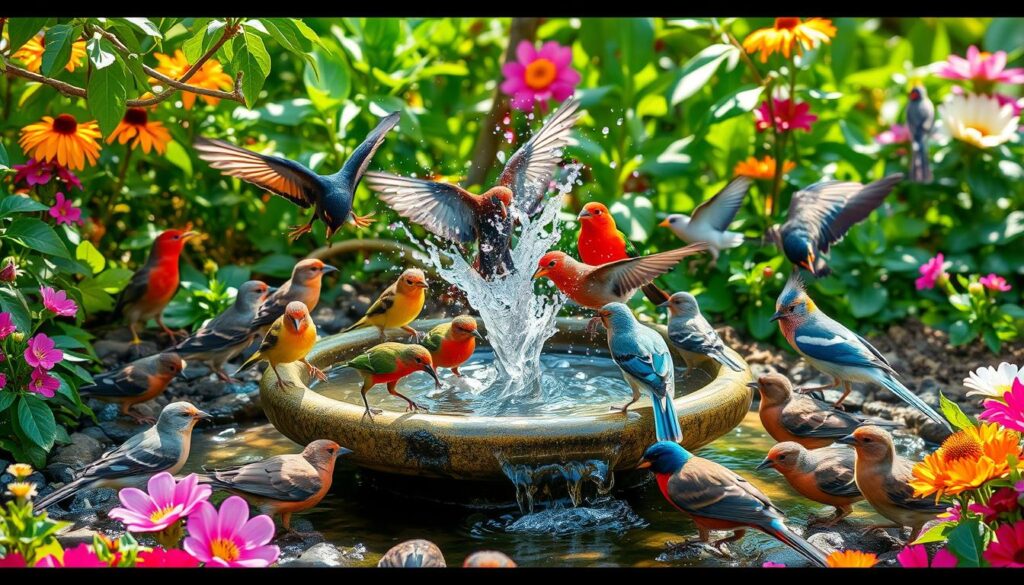

Muchas gracias. ?Como puedo iniciar sesion?
I am extremely impressed together with your writing skills as well as with the
layout to your blog. Is this a paid subject or did you customize it your
self? Either way keep up the excellent high quality writing, it’s rare to see a great weblog like this one these
days. Youtube Algorithm!
I am really delighted to read this weblog posts which includes tons of valuable facts, thanks for providing these data.
Feel free to surf to my web page: nordvpn coupons inspiresensation – http://t.co/y7mrgpy3QB,
nordvpn promo code 350fairfax
I love your blog.. very nice colors & theme. Did you make
this website yourself or did you hire someone to do it for you?
Plz answer back as I’m looking to create my own blog and would
like to know where u got this from. thanks a lot